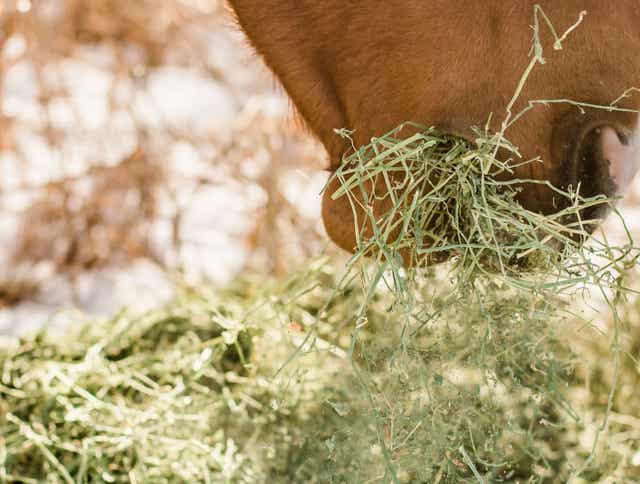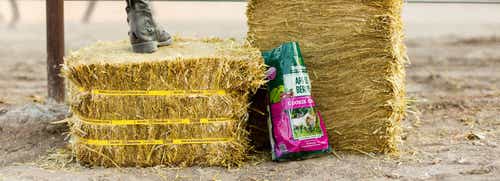
Selecting the Proper Forage for Your Horse
The most significant component of a horse's diet is forage in the form of pasture, baled hay, hay pellets, or hay cubes. Selecting the proper forage for your horse makes a big difference in satisfying the horse's nutritional needs; the appropriate forage can significantly impact the horse's health and longevity.
Forage Quality
Before we consider which type of forage may be best" for your horse, first, we need to ensure the forage is of good quality. Poor-quality forage will be lower in nutrient content and digestibility. Poor quality forage that contains dust or mold may also result in respiratory issues and digestive upset (colic) symptoms in horses. The main factors that influence the quality of forage are the specie of the plant, the stage of maturity, and the physical location where the plant was grown. Legume plants (alfalfa) are higher in protein, energy, and calcium than grass (Timothy, Orchard Grass) plants. The trace mineral and vitamin content of the plants tend to be regionally specific rather than plant-specific, depending on the soil the plant was grown in. The maturity of the plant is a significant determinant of forage quality. The more mature a plant becomes, or the taller a plant grows, the lower the quality. As plants mature, digestibility decreases due to increased fiber to keep the plant upright. Due to the high fiber content of mature plants, they proportionally contain less energy, protein, vitamins, and mineral. Pastures often become less digestible in mid-summer and autumn due to the plants becoming tall and mature.
Similarly, plants cut and dried for hay or hay pellets/cubes that are tall at harvest have a lower digestibility and nutrient content. The final determinant of forage quality is the physical location where the plant was grown. Different geographic regions contain soils with varying densities of nutrients. The nutrient content of the soil is reflected in the nutrient content of the plant. For example, plants grown in nutrient-deficient soil will also be nutrient-deficient and of lower quality.
Read more about forage quality
Determining Forage Quality
Forage quality can be determined to a limited extent by visual inspection of the forage. Visual inspection can include looking at the following:
- the leaf to stem ratio,
- the length of the seed head,
- color of the plant,
- and the presence of dust or mold
Higher quality hays will have more leaves than stems, a short seed head, be green in color, and smell fresh with no dust or mold. A more accurate evaluation of forage quality can be acquired via laboratory analysis. First, a representative forage sample is sent to the laboratory for chemical analysis. The results will then accurately determine the energy, protein, sugar/starch, and vitamin and mineral content. Laboratory analysis can be used to determine the presence of harmful mold.
Read more about determining forage quality
Selecting Forage
The goal in choosing the proper forage for your horse is to match the nutrient content of the forage with the horse's nutrient requirements. For example, horses with higher energy and protein requirements due to pregnancy, lactation, or growth should be fed forages with higher amounts of calories and protein. Forages with high energy and protein content include legume forages such as alfalfa or clover. Horses with lower protein and energy needs, such as mature horses or overweight horses, are often fed lower protein and energy forages, such as mature Timothy or Orchard grass. Mixed forages, containing both legumes and grass plants, have moderate amounts of protein and calories, making them perfect choices for horses engaged in competitive showing or moderate to heavy exercise. Several health issues, such as Cushing's Disease (PPID), Insulin Resistance (IR), and Tying-Up Syndrome, require horses to consume low-sugar/starch forages. Excellent low sugar/starch forages include Teff Grass, Bermuda Grass, and Alfalfa.
Regardless of the forage type selected to be your horse's "best" fit, always remember to feed high-quality forage to avoid respiratory issues and digestive upset.














